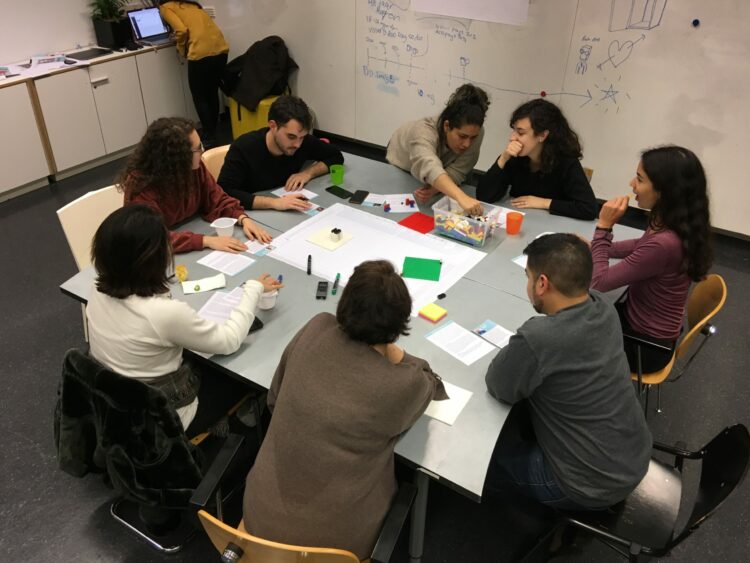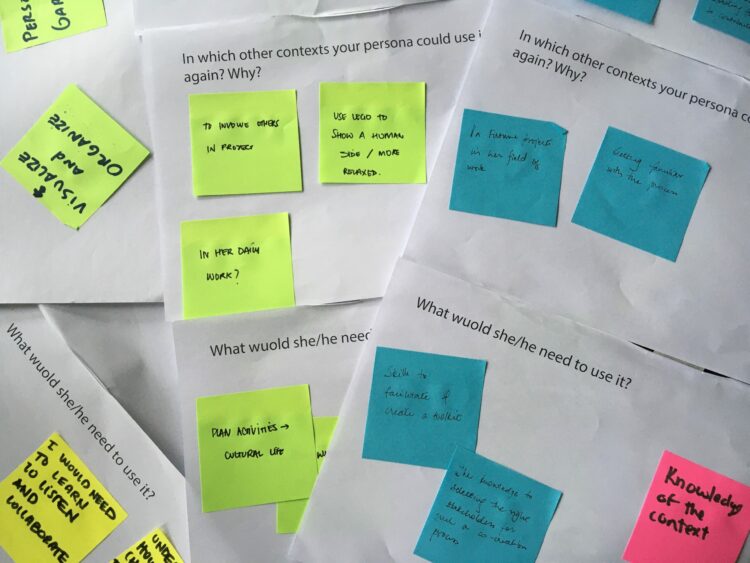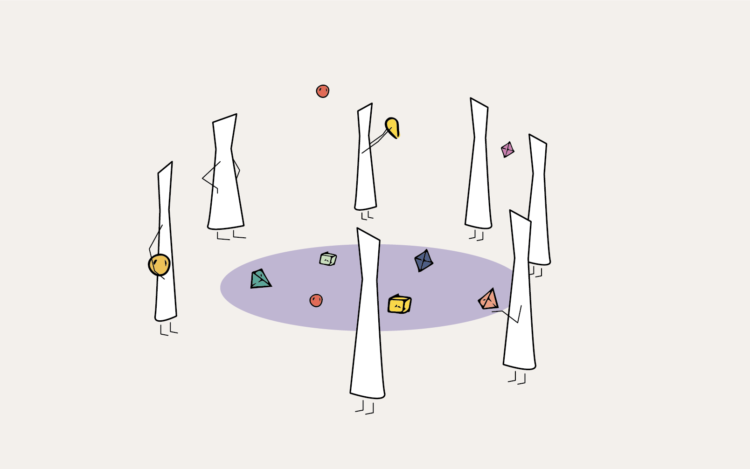What are participants really getting from taking part in your activities?
A look into the benefits of participation in design projects from the perspective of participants, and what designers could reflect on to make them happen
Participation has become a buzzword in design. More and more projects aim or claim to be participatory and put users at the centre, but have you ever asked yourself what people participating are actually getting out of that participation? You might say that by involving them you’re likely to design a solution that represents at best their concerns, needs and aspirations. That is already great, but is there more? Anything else that they might gain from participating? I asked myself these questions and what I found out is there’s actually more than the outcome of a project and especially when it comes to participatory projects, there is much that people can get from the experience of participating itself. Sounds interesting? With this small post, I tried to summarise what I found out that could make you reflect on that.
For my Honours Programme Master research project, I decided to conduct a research to understand what are the benefits for participants taking part in design projects and to find out what aspects of those processes play a role in enhancing those gains for them. To do so I first dived into literature and looked for existing studies, mainly coming from the Participatory Design domain, that had already addressed this topic. Afterwards, I selected a design project in collaboration with an organisation in Palermo (Sicily), in which I personally took part as a designer, as a case study to learn directly from participants about what they got out of that experience and reflect on the factors that contributed to that. The research concluded with a last research activity, the HPM seminar, that gave a chance to carry out a last investigation and reflect on the knowledge accumulated with peer designers and researchers. Here are the main takeaways from my research.


1. Participating is a chance for people to get aware of their current ‘ways of doing’ and approaches in regards to challenges
In most of the studies, people mentioned that they felt the opportunity to participate in a project as a chance to really think of how they do things right now. This includes the approaches they have in tackling challenges (eg. one addressed by the project itself), but as well a broader reflection on themselves as an organisation or community. Participants stated that during the activities, especially in a group, they noticed more clearly dynamics, behaviours and tendencies they and other people have when it comes to approaching a challenge. These insights helped them evaluate themselves and the ‘context’, figuring out possible ways for change or improvement.
As a designer, you could ask yourself:
- How can the activities in your project support people in reflecting on their current ‘ways of doing’?
- How could you make participants have the chance to more easily gain insights on their current approaches to things?
2. Taking an active part in participatory activities, people may become more aware of their own capabilities
When it comes to collaboratively and actively work on something, people are more likely to show up their skills, knowledge and attitudes. In a word, their own capabilities. In this process what was seen is that many participants actually became more aware of own capabilities that were either latent to them, or new to the project context. Freedom of experimentation and agency was many times felt as an important aspect by people interviewed. This gave them the chance to act more spontaneously and this let emerge what they were capable of. A ‘safe space’ can also give a chance to stop for a second and think. This may happen inside as well as outside the activities themselves and is important as it gives people a chance to reflect on what they are doing, and from there build self-awareness on own capabilities. This awareness is important as it might lead, as I’ll show next, to a whole reconsideration of someone’s agency and role within a context and community setting an important first step towards real empowerment.
As a designer, you could ask yourself:
- What different expertise do you think participants in your project might have?
- What particular knowledge, attitudes or skills do activities require?
- In what ways do the activities in your project leave space for the agency of participants?
- How much are the activities likely to make emerge the different capabilities of the people involved? Would they be explicit and recognisable?
- What ways could you find to support participants in reflecting on these capabilities, during or after your activities?
3. Participants may discover and acquire new skills, methods and attitudes useful to their own practices
In all the cases participants discovered as well new useful competencies. Some of them could even make their own. Methods, tools employed as well as skills and attitudes triggered by the activities (eg. active listening, communication skills etc.) were picked up by some participants that recognised their usefulness for further use. Participatory activities can make these things tangible for people and trigger mutual learning processes. Principles behind methods and tools become more tangible and easy to comprehend, their usefulness is directly experienced and the collective setting can push everyone to try things out. Triggering participants to reflect on these aspects could help them realise and articulate better what they found useful, and why or how they feel they could apply it again.
This happened for example in my previous project in Palermo, as two members of the organisations said they were positively impressed by the effect that visualisation and facilitation skills had on themselves and the group, and found their way to develop those skills for further use in their work.
As a designer, you could ask yourself:
- Which knowledge, skills, attitudes, methods or tools are you bringing in activities?
- How would you think of these as something that the people participating could find interesting to appropriate and use for their own purposes?
- How could your activities stimulate more or less direct mutual learning?
- How could you think of making more explicit the capabilities that everyone is bringing to the project?
- How tangible and recognisable are the principles of the approaches you are adopting in your activities? How could you help people grasp them?
- How could you help people grasp the usefulness of what others are capable of doing?
4. People might get to know each other during your project, with the opportunity to create or strengthen links and connections
A fourth common benefit that was reported by participants was the consolidation or sometimes the generation of new relationships with people. Participatory activities showed indeed to be a promising space for creating new connections, networks of people that many times are strengthened by common interests emerging indeed in the projects. On the other hand, activities made sometimes emerge people’s real interests, attitudes and maybe even latent capabilities. This has the potential of further consolidating existing networks, as it happened in the relatively young organisation in Palermo, giving more awareness of each other’s motivations and ‘missions’ regarding interests that might go way beyond the goals of the project itself, but that can be more capable of aligning people on the long term.
As a designer, you could ask yourself:
- Who are the different actors involved in your project and how are they currently or potentially connected to each other?
- How are you helping participants to really get to know each other through your project?
- What ways are there for them to express themselves so others can know them?
- How could you think of triggering opportunity for the building of relationships and connections between different participants in your project?
- What may prevent this to happen and what can act accordingly?
5. Participating in these processes can increase people self-confidence, perception of own agency and drive them to take future action
Wrapping up, positive experiences in participatory activities led people to reflect and consider multiple aspects. From their current capabilities and ‘ways of doing’, to new competencies they could acquire, or new or stronger connections with like-minded people.
All these factors contributed significantly in making many participants more confident of themselves, more aware of their role in bringing positive change and ultimately more capable of achieving the things they wanted. After the projects ended, people took concrete action in different ways. Some changed their career path towards developing skills and knowledge that were outside their previous expertise. Others became role models for others and ambassadors in their respective contexts. Some gained leverage in their workplace thanks to capabilities and knowledge emerged during the projects. Concluding, many were capable of ‘framing’ the role and actions that they desired to take in their respective contexts after figuring out that they were more capable of impacting it than they thought before. Even though these things happened outside the project itself, they somehow derived also from it.
Finally as a designer, you could ask yourself:
- How could we as designers support in reflecting on what was generated through this experience and what can happen beyond it?
- How could you make sure to include a moment in your project, for everyone to reflect and assess what’s been gained from this participatory experience?
- How could you trigger a reflection that may help people translate these benefits into future collective or individual actions?

The way participatory projects are designed can generate benefits for participants involved, that go beyond the mere outcome of the project. I hope these insights helped you to look at the involvement of users in design projects from a slightly different perspective, and to reflect on how you could act on your next projects to turn them into enriching experiences.